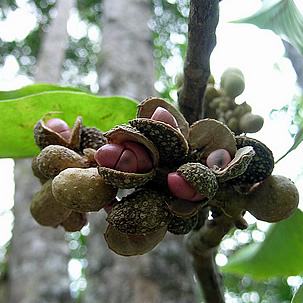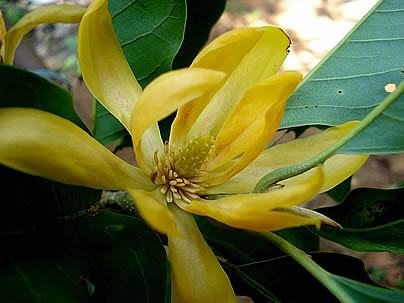The champak tree (Magnolia champaca) is an evergreen to semi-deciduous, ornamental tree native to Southeast Asia and known worldwide for the delightful fragrance of its flowers. It is considered of medium size, reaching up to 98 feet (30 meters) in cultivation, but in its natural habitat, it can grow up to 164 feet (50 meters) tall with a trunk diameter of up to 6.2 feet (1.9 meters). The trunk can be multiple or single, with an initially pyramidal crown that over time acquires an umbelliform shape (umbrella).
Its leaves are ovate to lanceolate, alternate, large, and shiny, with stipules at the base. The flowers consist of 15 recurved tepals at the tips and numerous stamens. They can be white, yellow, or pale yellow, depending on the variety, and their fragrance can be sensed from a distance. The fruits are formed by ellipsoid to obovate dehiscent carpels that produce two to four seeds. The seeds are covered with aril and are very attractive to birds.

In landscaping, the champak can be used either individually or in groups, fitting well into oriental and tropical styles. In groups, it can form rows or small groves, particularly along paths and roads where its fragrance can be appreciated. Similarly, plant it individually in passageways so that passersby can observe the flowers and enjoy the aroma.
Be careful not to plant it too close to windows and bedroom doors, as the strong fragrance may be bothersome to sensitive individuals. In India, it is considered sacred and planted around temples, both Buddhist and Hindu. Its wood, with fine texture, dark color, moderate resistance, and strong aroma, is used in the production of toys, boxes, art objects, furniture, and utensils, as well as in construction.
From the flowers of the champak, an essential oil with a rich fragrance is extracted, widely used in the perfume industry. It is one of the notes in the famous perfume “Joy” by Jean Patou. The flowers are also used in traditional necklaces (leis) to adorn women’s hair and decorate environments and water mirrors.
It should be cultivated in full sun, in fertile, deep, well-draining soil enriched with organic matter, and regularly irrigated in the first year of establishment. Despite being a tropical tree, the champak can tolerate light frosts once well established, making it suitable for the subtropical climate of the southern region and the high-altitude tropical climate of some municipalities.
Propagation is achieved through air layering and seeds, which should be sown in spring. Seeds should be collected when the fruits are about to open, before falling to the ground. They need to be scarified in water to remove all aril, which contains germination inhibitors. After scarification, plant them in sandy substrate, maintaining constant moisture. Germination occurs between one to two months after planting, with a success rate of 20 to 30%.


